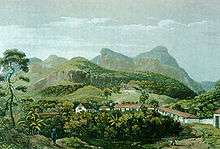Swiss Brazilians
Swiss Brazilians (Portuguese: helveto-brasileiros, brasileiros suíços) are Brazilian citizens of full or partial Swiss ancestry, who remain culturally connected to Switzerland, or Swiss-born people permanently residing in Brazil.
| Total population | |
|---|---|
| Unknown 500,000 (estimated descendants) | |
| Regions with significant populations | |
| Brazil: Mainly Southeastern Brazil | |
| Languages | |
| Portuguese, German, French, Italian | |
| Religion | |
| Christianity (mostly Protestantism and Roman Catholic) | |
| Related ethnic groups | |
| Other White Brazilian (especially German Brazilians, Austrian Brazilians, Luxembourg Brazilians, French Brazilians and Italian Brazilians), Swiss people |
In 1818, King John VI of Portugal, then resident in Rio de Janeiro, authorized the entry into Brazil of Swiss immigrants from the state (canton) of Fribourg (Switzerland). The parish was given the name of "São João Batista de Nova Friburgo" (Saint John the Baptist of New Fribourg) and was founded in 1820.
History
The history of Swiss immigration to Brazil began with the foundation of the colony of Nova Friburgo[1] in 1819. Nova Friburgo was the first colonial company contracted by the Portuguese government. The immigrant colonists wrote letters for publication in Swiss newspapers of the period, and these documents reveal the migrants' perceptions, information and expectations.
July 4, 1819 saw the departure from Estavayer-le-Lac, Lake Neuchatel, of 1088 Swiss immigrants, including 830 from the Canton of Fribourg, including Jean-Claude Marchon, his wife Marie Prostasie Chavannaz Marchon, his brother Antoine Marchon and his fiancee Marieanne Elizabeth Clerc, to Basel, the meeting point of the Swiss Transmigration for Brazil. On September 11 of the same year, 2006 Swiss immigrants travelled on the Rhein River to the Netherlands, departing from 's-Gravendeel, near Dordrecht, for the crossing of the Atlantic Ocean.

They arrived in Rio de Janeiro was on November 4, spending 55 days there. Finally, they arrive in Morro-Queimado (Burnt Mount) on November 15, 1819 – having traveled about 12000 kilometers in 105 days, approximately 114 kilometers a day.
In Morro-Queimado, in the forested mountains, about 140 kilometers from Rio, there were three big farms which had been acquired by King John VI. This area would serve as the destination point for the Swiss immigrants, and for the establishment of the Swiss Transmigration and the Foundation of a new city – Nova Friburgo (New Fribourg), which was named after the hometown of many of the immigrants. The Marchon family became the founders of Nova Friburgo. Marie Prostasie was the first Marchon to die in the New World, after having complications post-partum the day following the birth of her daughter, Marie Rosaline Marchon, on September 4, 1821. Marie Rosaline was the first daughter born to the Marchon family in the New World. About 20 years after, Marie Rosaline married with Swiss Henri Monnerat, son of Swiss immigrants François Xavier Monnerat and Elizabeth Köhler Monnerat.
Notable Swiss Brazilians
- Clóvis Bornay
- José Carlos Bauer
- A. C. Frieden
- Émil Goeldi
- Oswaldo Goeldi
- Cláudio Heinrich
- Adriana Lima
- Adolfo Lutz
- Berta Lutz
- Jorge Paulo Lemann
- Eric Maleson
- Gérard Moss
- Sabrina Sato
- Leticia Spiller